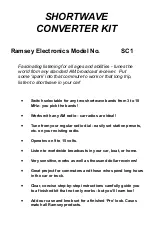
H0 Sound Decoder MX640 Page 43
11. Special - CV - Sets
This feature allows easy programming of a group of predefined values to the decoder’s appropriate
configuration variables. Such “CV sets” may be part of the decoder software at delivery (as listed
and described in the table below) or defined by the user.
Typical applications are: Railroad specific lighting, motor specific data for perfect slow speed behav-
ior, prototypical loco specific acceleration, easy switching between a passenger and goods train or
single loco versus consist.
Installation of such CV-sets (either supplied or self defined) is accomplished by a pseudo-
programming sequence of CV #8 (CV #8 contains “145”, the manufacturer code for ZIMO and can-
not really be overwritten, therefore the term pseudo-programming).
In contrast to the MX63 and MX64 HO decoders there are
no special CV sets available for the
MX640 decoders up to SW version 4.
This is in part because the relevant CV’s of the sound de-
coder are stored within the sound project.
The possibility of using self-defined CV sets is planned for future software versions.
Note to hard resets (are identical for CV-sets and sound projects):
CV #8 = 8
the common hard reset, will reset all configuration variables to default values according to
the CV-table in chapter 3.
On the other hand, the hard reset procedure initiated by programming the decoder to address 0 with
a ZIMO cab (MX2, MX21, MX31,…) will reset the decoder to the last defined special CV set. The
Norwegian loco, in the above example, will remain just that.
CV #8 = 0
the “traditional” hard reset – a procedure known from ZIMO cabs (MX2, MX21, MX31…by
programming an address to “0”) – will on the other hand reset the decoder to the last defined “spe-
cial CV set” or the lastly installed sound project!
12. Converting binary to decimal
If, according to the CV table, a CV calls for setting individual bits (which is the case with CV #29, 112
and 124, for example) proceed as follows:
Each bit has a specific value:
Bit 0 = 1
Bit 1 = 2
Bit 2 = 4
Bit 3 = 8
Bit 4 = 16
Bit 5 = 32
Bit 6 = 64
Bit 7 = 128
The decimal values of all bits of a CV that are supposed to be set are added up (Bit... = 1 in the CV-
table). All other bits (Bit....= 0) are ignored. Note that bits are numbered from right to left.
Example:
Bit 0, 2, 4 and 5 are supposed to be set (Bit...=1); but not the others (1, 3, 6 and 7).
This results in a bit-set of 00110101and a decimal value of:
Bit 7 Bit 6 Bit 5 Bit 4 Bit 3 Bit 2 Bit 1 Bit 0
0 0 1 1 0 1 0 1
0 + 0 + 32 + 16 + 0 + 4 + 0 + 1 = 53 (decimal value)
The calculation in reverse:
A trial and error method is used to determine individual bits from a decimal figure: start with the larg-
est value. If a number is larger or equal to 128 then Bit 7 = 1. If the remaining number is larger or
equal to 64 then Bit 6 = 1 and so on.
Example:
The decimal figure of 53 is neither larger or equal to 128, nor larger/equal to 64 but is larger than 32.
Therefore Bit 7 = 0, Bit 6 = 0 but Bit 5 = 1; the rest of 21 (53 - 32 = 21) is larger than 16 (Bit 4 = 1),
the remaining 5 (21 - 16 = 5) is not larger than 8 but is larger than 4 (Bit 3 = 0, Bit 2 = 1), and finally
1 (5 - 4 = 1) is not larger/equal to 2 but is equal to 1 (Bit 1 = 0, Bit 0 = 1).



































